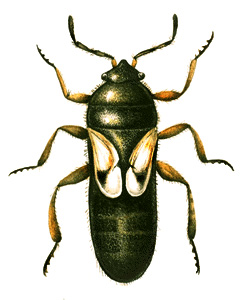Chinch bug is a small insect that feeds on plants. It sucks the juices of plants and is a pest of corn, sorghum, wheat, and other grains. Chinch bugs are found throughout the United States, Canada, Central America, and the Caribbean region. An adult chinch bug has a black body with whitish wings and measures about 1/6 inch (4 millimeters) long.

Adult chinch bugs spend the winter in grass or rubbish. In early spring, they move to pastures or fields of newly planted grain and lay eggs on roots and stems. The eggs hatch in about a week, and the young bugs feed on the roots and stems. In the middle of the summer, young chinch bugs crawl or fly into nearby fields of ripening grain. There, they lay eggs that become the next generation of chinch bugs. This second generation often causes extensive damage to crops, especially corn and sorghum. Chinch bugs develop most rapidly in warm, dry climates. In such climates, more than two generations of bugs may occur each year.
The chinch bug was once considered the most serious pest of corn and many other grains. Today, the bug is controlled by a variety of methods, including careful weed control, early planting of crops, and the use of plant varieties that are resistant to chinch bugs. Many farmers prevent damage to corn and sorghum by planting these crops away from grain fields where the bugs feed. Insecticides may be sprayed or dusted on fields to control a severe infestation of chinch bugs.
